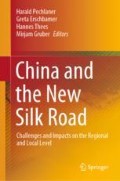Abstract
Central Asia has a long history of external influences, ranging from the historical Silk Road, to annexation by the Russian Empire and incorporation into the Soviet Union. After more than a century of strong ties with Russia in political, economic and socio-cultural terms, since 1991, Central Asia has become part of global trade and communication networks, meaning that its inhabitants have been exposed to the forces of globalisation. China’s “Belt and Road Initiative” marks a new dimension of external influences for Central Asia, not only through large infrastructure projects such as railway lines, highways and transit hubs, but also through a network of connectivity and cooperation, including trade and investment agreements and political treaties. These developments raise great hopes as well as fears in Central Asia. The paper will shed light on the reconfigurations of exchange relations and influences on Central Asia and discuss the related challenges, opportunities and risks facing the region.
Access this chapter
Tax calculation will be finalised at checkout
Purchases are for personal use only
References
Anastasiadou, E. (2017). Eiserne Seidenstraßen. Die transnationale Dynamik der Verkehrsinfrastrukturentwicklung im heutigen Asien [Iron Silk Roads. The transnational dynamics of transport infrastructure development in today’s Asia]. Zeitschrift für Weltgeschichte, 18(2), 115–137.
Barisitz, S. (2017). Aufstieg und Niedergang der Seidenstraße über zwei Jahrtausende. Ein kurzer Überblick. Zeitschrift für Weltgeschichte [Journal for world history]. 18(2), 15–25.
Contessi, N. P. (2016). Central Asia in Asia: Charting growing trans-regional linkages. Journal of Eurasian Studies, 7, 3–13.
Dorian, J., Abbasovich, U., Tonkopy, M., Jumabekovich, O., & Daxiong, Q. (1999). Energy in Central Asia and northwest China: Major trends and opportunities for regional cooperation. Energy Policy, 27, 281–297.
Duarte, P. (2018). China in the heartland: The challenges and opportunities of OBOR for Central Asia. In M. Laruelle (Ed.), China’s Belt and Road Initiative and its impact in Central Asia (pp. 11–20). Washington, D.C.: The George Washington University, Central Asia Program.
Freeman, C. (2018). New strategies for an old rivalry? China-Russia relations in Central Asia after the energy boom. The Pacific Review, 31(5), 635–654.
Heinrich, A. (2017). Die Rolle der Pipeline-Netzwerke in Zentralasien für die Energieversorgung Europas und Chinas [The Role of Pipeline Networks in Central Asia for the Energy Supply of Europe and China]. Zeitschrift für Weltgeschichte, 18(2), 197–213.
Hurley, J., Morris, S., & Portelance, G. (2018). Examining the debt implications of the Belt and Road Initiative from a policy perspective. (CGD Policy Paper, 121). Retrieved from https://www.cgdev.org/sites/default/files/examining-debt-implications-belt-and-road-initiative-policy-perspective.pdf.
Jaborov, S. (2018). Chinese loans in Central Asia: Development assistance or “predatory lending”? In M. Laruelle (Ed.), China’s Belt and Road Initiative and its impact in Central Asia (pp. 34–40). Washington, D.C.: The George Washington University, Central Asia Program.
Kohli, H. (2018). Looking at China’s Belt and Road Initiative from the Central Asian perspective. Global Journal of Emerging Market Economies, 9(1–3), 1–9.
Lain, S. (2018). The potential and pitfalls of connectivity along the Silk Road Economic Belt. In M. Laruelle (Ed.), China’s Belt and Road Initiative and its impact in Central Asia (pp. 1–10). Washington, D.C.: The George Washington University, Central Asia Program.
Laruelle, M. (2018). Introduction. China’s Belt and Road Initiative. Quo vadis? In M. Laruelle (Ed.), China’s Belt and Road Initiative and its impact in Central Asia (pp. x–xii). Washington, D.C.: The George Washington University, Central Asia Program.
Peyrouse, S. (2016). Discussing China: Sinophilia and sinophobia in Central Asia. Journal of Eurasian Studies, 7, 14–23.
Schmidt, M. (2013). Mensch und Umwelt in Kirgistan: Politische Ökologie im postkolonialen und postsozialistischen Kontext [People and Environment in Kyrgyzstan: Political Ecology in the Postcolonial and Postsocialist Context]. Erdkundliches Wissen 153. Stuttgart: Steiner.
Tian, H. (2018). China’s conditional aid and its impact in Central Asia. In M. Laruelle (Ed.), China’s Belt and Road Initiative and its impact in Central Asia (pp. 21–33). Washington, D.C.: The George Washington University, Central Asia Program.
Visser, O., & Spoor, M. (2011). Land grabbing in post-Soviet Eurasia: the world’s largest agricultural land reserves at stake. The Journal of Peasant Studies, 38(2), 299–323.
Author information
Authors and Affiliations
Corresponding author
Editor information
Editors and Affiliations
Rights and permissions
Copyright information
© 2020 Springer Nature Switzerland AG
About this chapter
Cite this chapter
Schmidt, M. (2020). Reconfigurations in Central Asia: Challenges, Opportunities and Risks of China’s Belt and Road Initiative. In: Pechlaner, H., Erschbamer, G., Thees, H., Gruber, M. (eds) China and the New Silk Road. Springer, Cham. https://doi.org/10.1007/978-3-030-43399-4_7
Download citation
DOI: https://doi.org/10.1007/978-3-030-43399-4_7
Published:
Publisher Name: Springer, Cham
Print ISBN: 978-3-030-43398-7
Online ISBN: 978-3-030-43399-4
eBook Packages: Economics and FinanceEconomics and Finance (R0)

